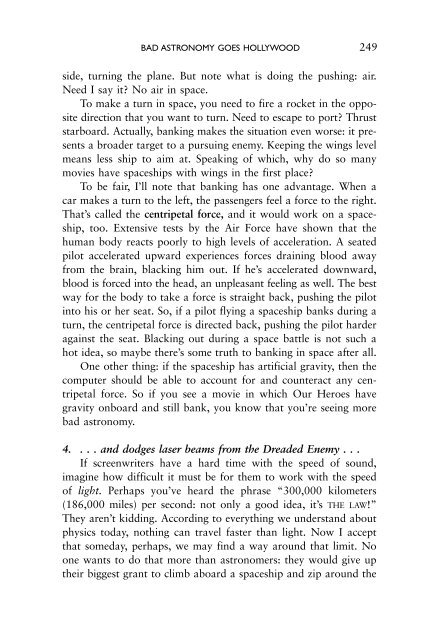Bad Astronomy: Misconceptions and Misuses Revealed, from ...
Bad Astronomy: Misconceptions and Misuses Revealed, from ...
Bad Astronomy: Misconceptions and Misuses Revealed, from ...
Create successful ePaper yourself
Turn your PDF publications into a flip-book with our unique Google optimized e-Paper software.
BAD ASTRONOMY GOES HOLLYWOOD 249<br />
side, turning the plane. But note what is doing the pushing: air.<br />
Need I say it? No air in space.<br />
To make a turn in space, you need to fire a rocket in the opposite<br />
direction that you want to turn. Need to escape to port? Thrust<br />
starboard. Actually, banking makes the situation even worse: it presents<br />
a broader target to a pursuing enemy. Keeping the wings level<br />
means less ship to aim at. Speaking of which, why do so many<br />
movies have spaceships with wings in the first place?<br />
To be fair, I’ll note that banking has one advantage. When a<br />
car makes a turn to the left, the passengers feel a force to the right.<br />
That’s called the centripetal force, <strong>and</strong> it would work on a spaceship,<br />
too. Extensive tests by the Air Force have shown that the<br />
human body reacts poorly to high levels of acceleration. A seated<br />
pilot accelerated upward experiences forces draining blood away<br />
<strong>from</strong> the brain, blacking him out. If he’s accelerated downward,<br />
blood is forced into the head, an unpleasant feeling as well. The best<br />
way for the body to take a force is straight back, pushing the pilot<br />
into his or her seat. So, if a pilot flying a spaceship banks during a<br />
turn, the centripetal force is directed back, pushing the pilot harder<br />
against the seat. Blacking out during a space battle is not such a<br />
hot idea, so maybe there’s some truth to banking in space after all.<br />
One other thing: if the spaceship has artificial gravity, then the<br />
computer should be able to account for <strong>and</strong> counteract any centripetal<br />
force. So if you see a movie in which Our Heroes have<br />
gravity onboard <strong>and</strong> still bank, you know that you’re seeing more<br />
bad astronomy.<br />
4. . . . <strong>and</strong> dodges laser beams <strong>from</strong> the Dreaded Enemy . . .<br />
If screenwriters have a hard time with the speed of sound,<br />
imagine how difficult it must be for them to work with the speed<br />
of light. Perhaps you’ve heard the phrase “300,000 kilometers<br />
(186,000 miles) per second: not only a good idea, it’s THE LAW!”<br />
They aren’t kidding. According to everything we underst<strong>and</strong> about<br />
physics today, nothing can travel faster than light. Now I accept<br />
that someday, perhaps, we may find a way around that limit. No<br />
one wants to do that more than astronomers: they would give up<br />
their biggest grant to climb aboard a spaceship <strong>and</strong> zip around the
















